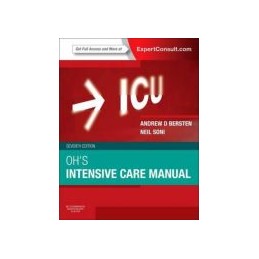- Obniżka


 Dostawa
Dostawa
Wybierz Paczkomat Inpost, Orlen Paczkę, DHL, DPD, Pocztę, email (dla ebooków). Kliknij po więcej
 Płatność
Płatność
Zapłać szybkim przelewem, kartą płatniczą lub za pobraniem. Kliknij po więcej szczegółów
 Zwroty
Zwroty
Jeżeli jesteś konsumentem możesz zwrócić towar w ciągu 14 dni*. Kliknij po więcej szczegółów
Whether youre a newcomer to the ICU or a seasoned practitioner, Ohs Intensive Care Manual delivers the practical, expert answers you need to manage the conditions you see every day in the intensive care unit. This highly esteemed, bestselling medical reference book presents comprehensive detail on each topic, while maintaining a succinct, accessible style so this information can be seamlessly incorporated into your daily practice.
Ohs Intensive Care Manual would represent a solid addition to any anesthesia departmental library as a resource or study aid. Reviewed by Canadian Journal of Anesthesia, Apr 2015
Opis
Part 1. Organisation Aspects
1. Design and organisation of intensive care units
2. Critical care outreach and rapid response systems
3. Severity of illness and likely outcome from critical illness
4. Transport of the critically ill patients
5. Physiotherapy in intensive care
6. Critical care nursing
7. Ethics in intensive care
8. Common problems after ICU
9. Clinical information systems
10. Clinical trials in critical care
11. Palliative care
12. ICU and the elderly
13. Health care team in intensive care medicine
14. Preparing for examinations in intensive care medicine
Part 2. Shock
15. Overview of shock
16. Haemodynamic monitoring
17. Multiple organ dysfunction syndrome
18. Monitoring oxygenation
19. Lactic acidosis
Part 3. Acute Coronary Care
20. Acute cardiac syndromes, investigations and interventions
21. Adult cardiopulmonary resuscitation
22. Management of cardiac arrhythmias
23. Cardic pacing and implantable cardioverter defibrillators
24. Acute heart failure
25. Valvular and congenital heart disease and bacterial endocarditis
26. Intensive care after cardiac surgery
27. Echocardiography in the intensive care unit
Part 4. Respiratory Failure
28. Oxygen therapy
29. Airway management and acute airway obstruction
30. Acute respiratory failure in chronic obstructive pulmonary disease
31. Mechanical ventilation
32. Humidification and inhalation therapy
33. The acute respiratory distress syndrome
34. Pulmonary embolism
35. Acute severe asthma
36. Pneumonia
37. Non-invasive ventilation
38. Respiratory monitoring
39. Imaging the chest
40. Ultrasound in the ICU
41. Extracorporeal membrane oxygenation (ECMO)
41.1 ECMO for respiratory failure
41.2 ECMO for cardiac failure
Part 5. Gastroenterological Emergencies and Surgery
42. Acute gastrointestinal bleeding
43. Severe acute pancreatitis
44. Liver failure
44.1 Acute hepatic failure
44.2 Cirrhosis and acute on chronic Liver Disease
45. Abdominal surgical catastrophes
46. Solid tumors and their implications in the ICU
Part 6. Acute Renal Failure
47. Acute kidney injury
48. Renal replacement therapy
Part 7. Neurological Disorders
49. Disorders of consciousness
50. Status epilepticus
51. Acute cerebrovascular complications
52. Cerebral protection
53. Brain death
54. Meningitis and encephalomyelitis
55. Tetanus
56. Delirium
57. Neuromuscular diseases in intensive care Part 8. Endocrine Disorders
58. Diabetic emergencies 59. Diabetes insipidus and other polyuric syndromes 60. Thyroid emergencies
61. Adrenocortical insufficiency in critical illness
62. Acute calcium disorders
Part 9. Obstetric Emergencies
63. Preeclampsia and eclampsia
64. General obstetric emergencies
65. Severe pre-existing disease in pregnancyPart 10. Infections and Immune Disorders
66. Anaphylaxis
67. Host defence and immunodeficiency disorders
68. HIV and acquired immunodeficiency syndrome
69. Severe sepsis
70. Nosocomial infections
71. Severe soft- tissue infections
72. Principles of antibiotic use
73. Tropical diseases Part 11. Severe and Multiple Trauma
74. Severe and multiple trauma
75. Severe head injuries 76. Faciomaxillary and upper airway injuries
77. Chest injuries
78. Spinal injuries
79. Abdominal and pelvic injuries
Part 12. Environmental Injuries
80. Submersion
81. Burns
82. Thermal disorders 83. Electrical safety and injuries
84. Envenomation
85. Ballistic injury 86. Background information on biochemical terrorism
Part 13. Pharmacologic Considerations
87. Pharmacokinetics, pharmacodynamics and drug monitoring in critical illness
88. Management and acute poisoning
89. Sedation and pain management in intensive care
90. Inotropes and vasopressors
91. Vasodilators and antihypertensives Part 14. Metabolic Homeostasis
92. Acid-base balance and disorders
93. Fluid and electrolyte therapy
94. Enteral and parenteral nutrition Part 15. Haematological Management
95. Blood transfusion
96. Colloids and blood products
97. Therapeutic plasma exchange and intravenous immunoglobulin therapy
98. Haemostatic failure
99. Haematological malignancy
Part 16. Transplantation
100. Organ donation
101. Liver transplantation
102. Heart and lung transplantation
Part 17. Paediatric Intensive Care 103. The critically ill child
104. Upper airway obstruction in children
105. Acute respiratory failure in children
106. Paediatric fluid and electrolyte therapy
107. Sedation and analgesia in children
108. Shock and cardiac disease in children
109. Neurological emergencies in children
110. Paediatric trauma
111. Withholding and withdrawing life-sustaining medical treatment in children
112. Paediatric poisoning
113. Paediatric cardiopulmonary resuscitation
Indeks: 100896
Autor: Pamela R Jeffries
Indeks: 11957
Autor: Janusz Andres
Indeks: 12700
Autor: red. wyd. pol. Bogdan Ciszek
Sonoanatomy for Anaesthetists
